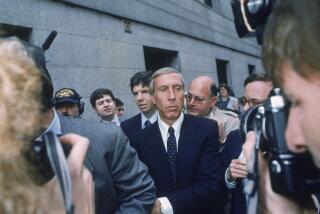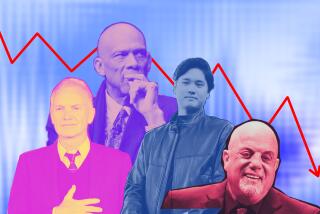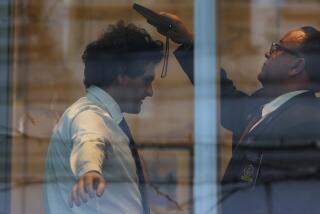White-Collar Prison Terms Under Debate
In late May, a 38-year-old Houston accountant and lawyer named Jamie Olis said goodbye to his wife and baby daughter and moved into a 79-square-foot cell at the Federal Correctional Institution in Bastrop, Texas.
It might be his home until 2028.
“I take no pleasure in sentencing you to 292 months,” U.S. District Judge Simeon Lake told the Dynegy Inc. executive as he handed down the sternest penalty yet in the post-Enron crackdown on corporate crime. “But my job is to follow the law.”
Yet what it means for judges to follow the law in punishing white-collar defendants has suddenly been tossed into limbo. A recent Supreme Court decision has cast doubt on the legality of the guidelines that determine federal sentences. That development could affect individuals convicted in the Justice Department’s campaign against corporate fraud -- a crackdown punctuated by last week’s indictment of former Enron Corp. Chairman Kenneth L. Lay.
Under the guidelines, a judge’s calculation of investors’ financial losses has largely determined the length of punishment. Late last month, the Supreme Court appeared to torpedo that approach, ruling that the facts used in sentencing must be considered by juries -- and not judges alone -- and proved beyond a reasonable doubt.
“That is a difficult standard, and unlikely to be met,” said Kirby Behre, a former U.S. prosecutor and coauthor of a book on federal sentencing for business crimes.
The Supreme Court case involved a crime far different from the kind Olis was convicted of.
The justices overturned an extra three years in prison given to a Washington state man who had kidnapped his estranged wife and their son. The trial judge had determined that the kidnapper displayed “deliberate cruelty” and therefore deserved prison time beyond the maximum 53 months set by the state’s sentencing guidelines.
But the Supreme Court said it was up to a jury to decide all aspects of a person’s guilt -- a finding that many lawyers and court watchers believe extends to federal white-collar cases as well.
The Olis case, some say, is Exhibit A in that regard.
“I’m not saying that this guy is blame-free,” said Avanidhar Subrahmanyam, a UCLA finance professor who has reviewed Olis’ sentence. “But the way it was computed is very questionable.”
In November, a Houston jury found Olis guilty of helping cook the books at Dynegy, the big Texas energy company. Olis was convicted of a battery of charges -- conspiracy, securities fraud, mail fraud and wire fraud -- related to an accounting scheme called Project Alpha, which cloaked $300 million of debt as revenue.
After the jury was dismissed, Lake -- a respected jurist who is chairman of the U.S. Judicial Conference’s criminal law panel -- began considering Olis’ sentence.
Under the sentencing guidelines, several factors -- including the skills required to perpetrate an accounting sleight-of-hand, the number of victims and a defendant’s criminal history -- contribute to the length of a prison term for a white-collar criminal. The most significant factor in determining a sentence in a corporate fraud case, however, is the monetary loss.
Yet pinning down that loss is far from an exact science, and there are strong indications that Lake may have missed the mark.
At Olis’ sentencing, Lake put the loss at a minimum of $105 million. He based that finding on his view of losses suffered by the University of California, a major Dynegy shareholder and lead plaintiff in a class-action lawsuit against the company.
During the trial, Jeffrey Heil, a former university investment official, testified that the UC system had lost a little more than $100 million on its Dynegy investment.
But in a recent interview, Heil made clear that he was not sure the punishment meted out to Olis was fair, considering the much lighter sentences given to senior corporate officers who have cut plea agreements in other cases.
“This doesn’t make a lot of sense,” said Heil, who served as UC’s co-head of investments until January 2003.
Notably, Heil never testified that Project Alpha cost the university system more than $100 million. Rather, he told the court that UC lost that amount during its overall period of owning Dynegy stock in 2001 and 2002, a time when the shares dropped for any number of reasons: the market-rocking Sept. 11, 2001, terrorist attacks; Enron’s spectacular collapse, which dragged down the whole energy sector; Dynegy’s ill-fated attempt to acquire Enron; and the California energy crisis, which raised fears of a broad regulatory clampdown.
Stock Sell-Off
To be sure, that time frame also included Dynegy’s negative disclosure that it was reclassifying $300 million from Project Alpha as debt and that the Securities and Exchange Commission was looking into the scheme. Those revelations sparked a major sell-off of the stock.
On April 25, 2002, the day Dynegy revealed those woes, its stock plunged 30%, falling to $19.21 from $27.30 a day earlier, an overall loss of $3.4 billion.
For all that, some experts say it is difficult to assign a clear-cut loss to the Project Alpha disclosures because the bad news reinforced other, long-standing concerns hovering around the company and industry.
“Everything else in that universe was going down, just like one of these big water slides you see in the playground,” said John Olson, a respected energy analyst with investment firm Sanders Morris Harris in Houston. Project Alpha “was just one more nail in the coffin.”
Said Steven R. Grenadier, a professor of financial economics at Stanford University: “Clearly, just looking at the stock price highs and lows, without factoring in the timing of information events or considering the impact of the industry and overall market, is not an accurate manner of judging the effect of a manager’s actions.”
More Questions
There also are new questions about trial testimony that may emerge during Olis’ appeal.
At the trial, Assistant U.S. Atty. Belinda Beek referred Heil to a chart showing the steep drop in Dynegy’s stock on April 25 and asked Heil whether the decline was triggered by the negative news over Project Alpha.
“Yes,” he said, adding, “and this is when we also decided to sell the stock.”
But, in fact, UC continued to buy Dynegy stock -- 900,000 shares on May 6 and May 7, according to a summary of trades the university system provided to The Times.
In the interview, Heil said that he couldn’t recall those specific purchases. He speculated that they might have been made “because you think the stock has declined more than the bad news warrants.” However, Dynegy’s stock continued to fall, and UC sold all its shares in the following weeks, dumping them at a loss that Lake would eventually lump into his sentencing calculation.
If the university’s losses were limited to declines in Dynegy after the negative revelations of April 25, and the May purchases were not considered, UC’s losses might have totaled about $59 million, depending on the method of calculation, UCLA’s Subrahmanyam said. By that count, Olis’ sentence could be five years shorter under the sentencing guidelines.
Maybe Olis did “something bad and he deserves time, but his time should be rationally based,” said Behre, a lawyer with Paul, Hastings, Janofsky & Walker in Washington. “We are now basing sentences directly upon numbers which are little more than guesswork.”
Lake declined to be interviewed. So did Olis, who is appealing both the verdict and the sentence.
Meanwhile, in the wake of the Supreme Court’s decision, Olis attorney David Gerger has filed a motion asking for his client to be released pending appeal. Gerger argued that lacking the jury’s endorsement of the $100-million-plus loss, Olis’ sentence should be no longer than six months.
For their part, federal prosecutors have sought to describe Olis as the mastermind of Project Alpha, more central to the plan than even his boss, who testified against him and, under a plea agreement, was sentenced to five years in prison.
“Olis was everywhere, involved in all major meetings, even those from which his superior was excluded,” Assistant U.S. Atty. Jimmy R. Sledge Jr. wrote the judge before the sentencing.
The government urged Lake to figure investors’ losses at more than $500 million -- and perhaps twice that amount -- based on the hit taken by all shareholders, not just the university. Prosecutors submitted a consultant study that considered the entire decline in Dynegy’s market value and attempted to screen out factors unrelated to Project Alpha.
The defense countered that it was impossible to accurately separate the losses tied to the fraud, given the array of pressures bearing down on Dynegy.
In the end, Lake sought to simplify the matter by focusing on UC’s investment alone.
Toughest Tier
By holding Olis responsible for more than $100 million in losses for the university, the judge moved the defendant into the toughest tier of sentences, under guidelines approved in 2001 by a federal commission. Had Olis been sentenced in 2000, his jail term might have been less than half of what he ended up with.
The official view at UC is that Olis’ punishment fits the crime.
“The Olis sentence reflects the ... significant damage that the Dynegy fraud has inflicted on the company’s shareholders,” said Trey Davis, director of special projects for the UC system.
Yet Heil, who now works for the Doris Duke Charitable Foundation in New York, acknowledged in the interview that he couldn’t place a dollar value on the UC losses tied specifically to Project Alpha.
It was not a number he was asked to single out at trial.
“To be truthful,” he said, “I wouldn’t have known the figure.”
More to Read
Inside the business of entertainment
The Wide Shot brings you news, analysis and insights on everything from streaming wars to production — and what it all means for the future.
You may occasionally receive promotional content from the Los Angeles Times.










